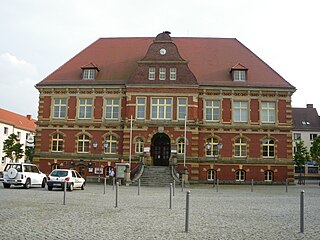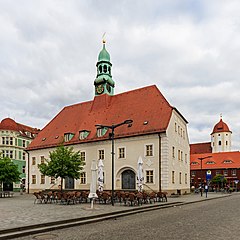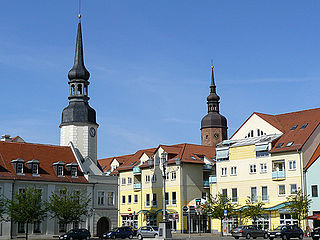
The Lower Lusatia is a region in the south of the country Brandenburgwhich historically extends a little way into Poland. The most famous travel destination of Niedelausitz is certainly the Spreewald with its scattered farmhouses and villages and its countless rivers that invite you to paddle. The entire region is also well developed for cycling.
Regions
- Lusatian border wall - The landscape southwest of the Spreewald stretches from the Niedere Fläming to the Muskau folds.
- Loveless heather - Heathland north of Cottbus.
- Lower Lusatian Neisse - the eastern border area with Poland along the Lusatian Neisse.
- Spreewald - One of the most famous landscapes in Brandenburg and actually also in Germany.
- Through the lignite opencast mining in the southern Lower Lusatia and the northern Upper Lusatia is with the Lusatian Lakeland a new landscape emerged.
- Historically, Niederlausitz extends a little further east into the neighboring Polish voivodeship Lebus into it, even if it is now perceived as a region exclusively located in Germany. The eastern end of Niederlausitz was through the river Bober(Bóbr) described.
places

The following places are the largest in the region and are ideal starting points for exploring Niederlausitz.
- 1 cottbus
 is the largest city in Lower Lusatia, located between the Spreewald, Lausitzer Grenzwall and Lieberoser Heide, and is considered the cultural center of the Sorbs. The city is convenient to visit many interesting places. Cottbus is on the doorstep of the famous Spreewald. To the south is the Lusatian Lakeland. After the Cottbus Nord opencast mine has been flooded, the largest lake in the Lakeland will even be on the doorstep. But also the beautiful Schlaubetal north of the city can be easily reached as a day trip.
is the largest city in Lower Lusatia, located between the Spreewald, Lausitzer Grenzwall and Lieberoser Heide, and is considered the cultural center of the Sorbs. The city is convenient to visit many interesting places. Cottbus is on the doorstep of the famous Spreewald. To the south is the Lusatian Lakeland. After the Cottbus Nord opencast mine has been flooded, the largest lake in the Lakeland will even be on the doorstep. But also the beautiful Schlaubetal north of the city can be easily reached as a day trip. - 2 Calau
 is located 25 km west of Cottbus. The nearby Calauer Switzerland invites you to hike to the Plinsdörfern one and to the west and south-west are some developed lakes from former open-cast mines.
is located 25 km west of Cottbus. The nearby Calauer Switzerland invites you to hike to the Plinsdörfern one and to the west and south-west are some developed lakes from former open-cast mines. - 3 Finsterwalde
 is known by the Finsterwalder Singing Festival which has been taking place in the city since 1954 and is based on an old song.
is known by the Finsterwalder Singing Festival which has been taking place in the city since 1954 and is based on an old song. - 4 Forest
 old clothmaker town and border town with Poland. The city's rose garden is known nationwide,
old clothmaker town and border town with Poland. The city's rose garden is known nationwide, - 5 Guben
 is on the border to Poland together with its twin town Gubin. It is known Plastinarium by Prof. Gunther von Hagens. There has been a demonstration workshop here since the end of 2006.
is on the border to Poland together with its twin town Gubin. It is known Plastinarium by Prof. Gunther von Hagens. There has been a demonstration workshop here since the end of 2006. - 6 Lauchhammer
 is characterized by mining. Here you will find the art casting museum and the bio towers, parts of an old coking plant.
is characterized by mining. Here you will find the art casting museum and the bio towers, parts of an old coking plant. - 7 Schwarzheide
 is a young city that was founded in 1936 in connection with a lignite synthesis plant.
is a young city that was founded in 1936 in connection with a lignite synthesis plant. - 8 Senftenberg
 is the starting point for exploring the Lusatian Lakeland
is the starting point for exploring the Lusatian Lakeland - 9 Spremberg
 City on the Spree with a castle, some remarkable buildings and a charming environment.
City on the Spree with a castle, some remarkable buildings and a charming environment.
In the small historical part on the Polish side (Łużyce Dolne) the following places are located.
- 10 Brody
 (Gates) is a small place in the voivodeship Lebus in Poland and lies in the border area of the historical regions Lausitz and Lower Silesia about 5 kilometers east of the German border town Forst (Lausitz). Brody is known for the ruins of the baroque Brühlpalast, which has been restored since 2013.
(Gates) is a small place in the voivodeship Lebus in Poland and lies in the border area of the historical regions Lausitz and Lower Silesia about 5 kilometers east of the German border town Forst (Lausitz). Brody is known for the ruins of the baroque Brühlpalast, which has been restored since 2013. - 11 Gubin
 is the Polish half of the border town Guben.
is the Polish half of the border town Guben. - 12 Jasień
 (Alleys) lies between Lubsko and Żary and has an old baroque final ruin. Not far from the place there is a 15 ° meridian point.
(Alleys) lies between Lubsko and Żary and has an old baroque final ruin. Not far from the place there is a 15 ° meridian point. - 13 Lubsko
 (Summer field) is located about 30 from the border and offers a small old town as well as a small inviting lake for recreation.
(Summer field) is located about 30 from the border and offers a small old town as well as a small inviting lake for recreation. - 14 Żary
 (Sorau) is in particular for its historic old town with the Biberstein Castle and the Promnitz Castle and the forest area to the south Zielony Las(Sorau Forest) known. In addition, the place offers good opportunities for excursions, for example to Żagań and Iłowa.
(Sorau) is in particular for its historic old town with the Biberstein Castle and the Promnitz Castle and the forest area to the south Zielony Las(Sorau Forest) known. In addition, the place offers good opportunities for excursions, for example to Żagań and Iłowa.
Other goals
background
Lower Lusatia got its name from the Slavic tribe of the Lusici, who lived between the Bober and Oder in the east and the Black Elster in the west, and was subjugated by Margrave Gero in 963 and incorporated into the German Empire. Initially part of the so-called Ostmark, this land later formed a special Mark Lausitz, which after frequent changes of rulers in 1136 to Konrad the Elder. Size came from Meissen and now, now united with Meissen, soon separated from it again, remained in the possession of the Wettins until 1303 Diezmann felt compelled to sell his land to the Margraves of Brandenburg. So now the two parts of the Lausitz stood together for a short time under the Brandenburg Ascanians. When in 1319 with Waldemar d. Size this house was extinguished, King Ludwig gave the Bavarian Brandenburg and the other states still connected with it to his son Ludwig zu Lehn in 1324. The Wittelsbach family gave Niederlausitz several times to neighboring princes (Meißen, Schweidnitz) pledged and finally ceded completely to Emperor Charles IV in 1373. Since then incorporated into the Bohemian state, it had settled individual new pledges, had the same sovereigns and fates as Upper Lusatia. Due to the traditional recession of May 30, 1635 and the traditional farewell on April 24, 1636, the two parts were completely ceded to Electoral Saxony. In 1815 all of Lower Lusatia and half of Upper Lusatia came from Saxony to Prussia.
regional customs
The ancestors of the region believed in spirits of vegetation and fertility, which manifested themselves in the form of animals. One believed that Rooster (Lower Sorbian: cocot) can influence the harvest with his forces. At the end of the growing season, he hid under the last sheaf. This last sheaf was adorned with flowers and ribbons. The exclamation "Lower Sorbian: Źins jo kokot- today is kokot“Announced the end of the harvest. The Cock plucking (Lower Sorbian: £ apanje kokota), a harvesting practice, can still be found in some villages around cottbus at. For this purpose, a gate was built on the field from decorated beams. A dead cock was tied upside down to the crossbeam. Now the boys have to ride through the gate one after the other. Whoever is the first to tear off the rooster’s head is considered the first king of the harvest. If you tear off the wings, you will be 2nd or 3rd harvest king. All blindfolded now select their dance partners for an honor dance. Harvest queens are also determined through competitions (frog carts, bachelor carts or egg-running).
The Zampern serves to drive out winter. It takes place on Shrove Tuesday. Young people go from house to house in carnival costumes. Money will be collected for the upcoming carnival activities. The donors get a schnapps and a serenade for it. The children who move through the village are given sweets.
language
The Lower Lusatian dialect, a dialect from southern Markia, is often relegated to the corner of Berlin. However, there are also clear Saxon influences, even if some Brandenburgers don't like to hear that. The dialect can perhaps be described as a bit sloppy High German, in which a letter is often swallowed. A typical example is “r”. If it is not at the beginning, you can hardly hear it from Niederlausitz people. Pronounced by a local, the region is the “Niedalausitz ". A short “i” often becomes a “ü” and an “e” for words that end in “-en” tends to simply disappear. The fact that the “ge” sometimes becomes the “ever” is reminiscent of Berliners. So "throw the locals somewhere".
One encounters a local language in Niederlausitz - that Lower Sorbian (Lower Sorbian: Dolnoserbšćina, dolnoserbska rěc), often on site as Wendish designated. This West Slavic language is one of the two Sorbian languages that Upper Sorbian is spoken in Upper Lusatia. Visitors to the region are most likely to notice this when there is often bilingual signage for streets and places. The only German institute for Sorabistics, however, is in Leipzig. The number of speakers in Lower Sorbian is now assumed to be around 10,000. The center is the city cottbus, in which there is also a Sorbian high school as well as the surrounding villages. In the village Diss In 1995, 29% of the Wendish population were still powerful.
getting there
mobility
The Transport Association Berlin-Brandenburg (VBB) organizes local public transport in Berlin and Brandenburg.
The Berlin-Brandenburg region has a dense network of regional express and regional train lines, which are often supplemented by excursion buses at tourist destinations. Most of Brandenburg's tourist destinations can be easily reached hourly or every two hours. In Brandenburg and Berlin you can use the Brandenburg-Berlin tickets Travel comfortably and inexpensively with up to 5 people at a price of € 29. The ticket is valid Monday to Friday from 9 a.m. and on the weekend all day until 3 a.m. the following day in all local transport. Night owls pay only € 22 between 6 p.m. and 6 a.m. the following day. Individual travelers can use the day ticket for the entire VBB network at a price of € 21.
Tourist Attractions

Observation towers and points
Even if the Lower Lusatia is only a partially slightly undulating landscape, you can still find some points from which you can look into the country.
- The 1 Bismarck Tower. in Burg (Spreewald) offers a beautiful panoramic view of the green crown sea of the upper Spreewald.
- 2 Rusty Nail. From up here you have a beautiful view of the Sorno Canal and the surrounding lakes and forests of the Lusatian Lake District.
- 3 Merzdorf observation tower. The observation tower in the east of the city of Cottbus offers a wide view over the future Cottbus Baltic Sea, which was created from the former Cottbus-Nord opencast mine.
- Also at the Cottbus Nord opencast mine, in Neuendorf a new 50m high tower opens its doors - with a wide view of the landscape of Niederlausitz,
- Lookout tower on Lake Felix - The tower stands in the hilly forest landscape of the Muskauer fold arch
- Bismarck Tower at Spremberg
- The Tower on the Wehlaberg is 23m high and offers a wide view of the Krausnicker Mountains, Tropical Island and, in good weather, as far as Berlin.
_-_Bismarckturm.jpg/124px-Burg_(Spreewald)_-_Bismarckturm.jpg)
Castle (Spreewald)
Rusty Nail

Merzdorf
activities
- 1 Tropical Island. Tel.: 49 (0)35477 60 50 50, Fax: 49 (0)35477 60 60 60, Email: [email protected]. Europe's largest tropical vacation world is located in the largest self-supporting hall in the world and contains a South Sea beach, a rainforest, a tropical village and much more. Bathing, sauna and fun for the whole family.
- Sports and leisure park Pond land. The main attraction is a 900m long summer toboggan run
literature
- Kerstin and André Micklitza: Lausitz. On the way between the Spreewald and the Zittau Mountains. Travel guide, 5th updated and expanded edition, Trescher Verlag, Berlin 2015, ISBN 978-3-89794-330-8
- Günter Wetzel: Teutons - Slavs - Germans in Lower Lusatia. In: Report of the Roman-Germanic Commission, vol. 83, Mainz 2002, pages 206-242, ISSN 0341-9312
- Rudolf Lehmann: History of Lower Lusatia. Publications of the Berlin Historical Commission, Volume 5, Berlin 1963




_Markt.jpg/350px-Forst_(Lausitz)_Markt.jpg)





.jpg/320px-Palace_Brody_(powiat_zarski).jpg)
.jpg/331px-Gubin_-_fotopolska.eu_(338079).jpg)

,_1_poł._XIII,_XIVXV.JPG/350px-611777_Lubsko_ratusz,_1580_611773_Lubsko_kościół_par._p.w._Nawiedzenia_NMP_(dec._p.w._Najśw._Serca_Jezusa),_1_poł._XIII,_XIVXV.JPG)




_-_Bismarckturm.jpg/124px-Burg_(Spreewald)_-_Bismarckturm.jpg)


